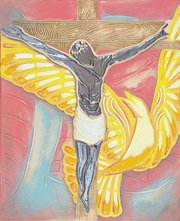The hyper-modern architecture of the new Holy Family Catholic Church on Robinson and Claridge Roads on the outskirts of Nassau celebrates light. In daylight an abundance of windows allows light to flood in and illuminate the ecclesial structure.
The new Holy Family also boasts of the ground-breaking art of the 14 Stations of the Cross and 42 sculptures of birds in flight representing the Holy Spirit, angels in various postures and large and small crosses distributed throughout the sanctuary, the Blessed Sacrament Chapel and elsewhere. The panels representing the passion of Christ and the larger crosses are embellished with relief illustrations of personages and symbols sacred to Christianity, all hand-built from clay, carved, fired, glazed and fired again in the Bahamas by a Bahamian. This collection of 56 pieces is the work of Bahamian artist Neko Meicholas.
Neko Meicholas, owner of Guanima Press is best known for his work in publishing and book design. But Meicholas is first and foremost a multimedia artist: a graphic designer, illustrator, photographer and, more recently, ceramicist. It is the latter art that he chose to extol, when commissioned by the leader of the Bahamas Catholic flock in the Bahamas and Turks and Caicos Islands, Archbishop Patrick C. Pinder.
The Stations are made entirely of clay shaped to represent canvases with carved faces and side supports, which have been high-fired to enduring stoneware.
“When I received the commission from Archbishop Patrick Pinder to create 14 Stations of the Cross for the new Holy Family Church, I was elated. As I actually began the design process, elation turned to worry and dread. What medium would serve best to carry a message so important to so many? How large should the main pieces be? Would the final piece fit in the kiln for firing? How to construct them so that they would survive the drying process and then the firing process? How to support them so that they would not sag and warp horribly during firing? What colours to use? There were so many doubts,” said Mr Meicholas.
Meicholas wanted to make certain that he understood enough of the theology and the iconography, so he immersed himself in research that took him, via books and the internet to churches in many countries to understand the parameters, what was permissible and what was not. He wanted to have a heartfelt understanding of what it all meant and why such icons have been perpetuated for two millennia in communities across the globe. He was determined to break new ground, and the breakthrough would come in more than the art.





Comments
Use the comment form below to begin a discussion about this content.
Sign in to comment
Or login with:
OpenID